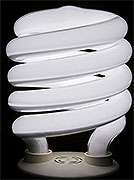Could compact fluorescent bulbs pose skin cancer risk?

(HealthDay) -- As the United States bakes under the summer sun, dermatologists often warn of cancer risks posed by ultraviolet (UV) sunlight. But research now points to a new and ubiquitous indoor source of these harmful rays: eco-friendly compact fluorescent light bulbs.
Scientists say they found widespread chipping or cracking in the phosphor surface coating of nearly all the compact fluorescent bulbs they examined, allowing UV rays to escape.
Most of the bulbs "have cracks in the phosphor coating, probably due to the fact that the coating is brittle and has trouble making the tight bends required to make these bulbs compact," explained study lead author Miriam Rafailovich, a professor of materials science and engineering and director of the Garcia Center for Polymers at Engineered Interfaces at Stony Brook University in Stony Brook, N.Y. "As a result, we observed, by eye, defects in nearly all the bulbs that we studied."
And, Rafailovich added that, "skin cells exposed to [compact fluorescent light] emissions showed the same damage as those exposed to UV light" when placed in close range (meaning less than one foot) to a CFL bulb.
The study is funded by the U.S. National Science Foundation and is published in a recent issue of the journal Photochemistry and Photobiology.
As Americans grow more concerned about environmental and energy issues, millions have made the switch from the old incandescent bulbs to compact fluorescents. The U.S. National Institutes of Health notes that the newer technology uses roughly 75 percent less energy than standard incandescent bulbs.
Each compact fluorescent bulb has a phosphor coating applied to its narrow glass tubing. The coating is designed to both enhance the bulb's luminescence capacity while at the same time absorbing UV radiation that would otherwise be emitted.
But the authors warn that if the bulb's surface area is riddled with "bald" spots, UV protection is lost.
To see how widespread the problem might be, the Stony Brook team set out to purchase a wide array of compact fluorescent bulbs commercially available in stores across the Suffolk and Nassau county regions of Long Island, N.Y.
They measured each bulb for levels of UV emissions, while at the same time examining each for signs of cracking in its phosphor coating.
The result: All the bulbs, regardless of manufacturer or brand, were found to emit "significant" levels of both UVC and UVA rays as a result of cracks in their respective applied coatings.
Further laboratory testing revealed that when healthy human skin cells were exposed to the UV emitted from the bulbs, damage ensued that was "consistent" with the damage typically caused by UV radiation from the sun.
By contrast, exposure to incandescent bulbs of similar strength prompted no skin cell damage.
According to Rafailovich, "these bulbs are fragile, the phosphor is easily damaged, and possibly dangerous amounts of UV are emitted. Therefore, it's best not to use these bulbs at close range -- less than a couple of feet -- or look directly at them. To be safe, they should be used behind a glass cover, or kept at a distance of several feet or more."
Rafailovich said it's incredible that this situation has arisen at all. "You should not need suntan lotion to protect you from indoor lighting," she said.
In any case, one dermatologist believes using sunscreen each day is a good way to keep the UV away, whatever the source.
Dr. William Ting is a private practice dermatologist and medical director of California Dermatology Care in San Ramon, Calif. He said that doctors "have always had some suspicion about these bulbs in terms of exactly how much UV is getting through to patients. However, I don't think we're going to slow down the adoption of this technology, which means that people will increasingly find themselves in environments where they have no control over the use of these light bulbs."
His advice: "Everyone should be wearing sunscreen every single day no matter what, because even a short commute from home to work can lead to sun damage over time. And if everyone adheres to that there's no reason to be concerned about this issue."
Another expert agreed.
"Recommending that people apply sunscreen every day is always good advice," said Dr. Darrell Rigel, a clinical professor of dermatology at NYU Langone Medical Center in New York City. "That said, I'm not sure what the risk is here. Is it a risk of some kind? Yes. It is a big risk? Probably not. And I would not alarm people that they're going to get skin cancer because they're exposed to a compact fluorescent [bulb]."
"For example," Rigel said, "most people work in offices within five to six feet of the long, standard fluorescent light bulbs that everyone is familiar with. And over the course of a typical work year of 2,000 hours you'd get the equivalent of about 20 minutes of street sun exposure in NYC in September. In other words, not a lot. So while more research is needed, at this point I wouldn't have people panicking about this."
The American Lighting Association, an industry group representing light bulb manufacturers, did not respond to HealthDay requests for comment.
More information: Find out more about compact fluorescent bulbs at the U.S. National Institutes of Health.
Copyright © 2012 HealthDay. All rights reserved.


















